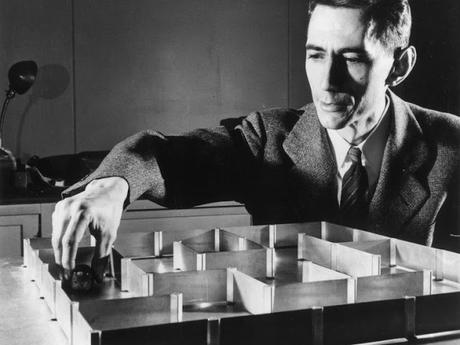 Theseus, created in
1950, was a magnetic mouse controlled by a relay circuit that enabled it to
move around a maze of 25 squares. Its dimensions were the same as those of an
average mouse. The mouse was designed to
search through the corridors until it found the target. Having travelled
through the maze, the mouse would then be placed anywhere it had been before
and because of its prior experience it could go directly to the target. If
placed in unfamiliar territory, it was programmed to search until it reached a
known location and then it would proceed to the target, adding the new
knowledge to its memory thus learning.Shannon's mouse appears to have been the
first artificial learning device of its kind.
Claude Elwood
Shannon (1916- 2001) was an American mathematician, electrical engineer, and
cryptographer. Shannon is famous for
having founded information theory with a landmark paper that he published in
1948. He is perhaps equally well known for founding both digital computer and
digital circuit design theory in 1937, when, as a 21-year-old master's degree
student at the Massachusetts Institute of Technology (MIT), he wrote his thesis
demonstrating that electrical applications of Boolean algebra could construct
any logical, numerical relationship. Shannon contributed to the field of
cryptanalysis for national defense during World War II, including his basic
work on code-breaking and secure telecommunications.
In its time the
Google Doodle has celebrated mathematicians and eminent people, today it was the
turn of Claude Shannon, who worked with Turing on Allied codebreaking during
the Second World War; although Shannon's war-time work was crucial to the
Allied effort, he did devote some of his energies to more frivolous projects. Shannon built the world's first juggling
robot, using an Erector Set; the robot, which was built to look like the
Vaudevillian and film comedian WC Fields, was able to juggle three balls at one
time - but bounced and caught them, rather than throwing them in the air and
catching them.
Shannon built what
he called the Ultimate Machine, which he kept on his desk. It was a simple box
with a single switch on it that, when pressed, opened the box's lid to reveal a
mechanical hand that reached out, flipped off the switch. Shannon was fascinated by game theory, and
used to visit Las Vegas with his wife, Betty, and fellow MIT mathematician Ed
Thorpe. There they used to play Blackjack, using their mathematical theories to
count and predict card sequences.
Theseus, created in
1950, was a magnetic mouse controlled by a relay circuit that enabled it to
move around a maze of 25 squares. Its dimensions were the same as those of an
average mouse. The mouse was designed to
search through the corridors until it found the target. Having travelled
through the maze, the mouse would then be placed anywhere it had been before
and because of its prior experience it could go directly to the target. If
placed in unfamiliar territory, it was programmed to search until it reached a
known location and then it would proceed to the target, adding the new
knowledge to its memory thus learning.Shannon's mouse appears to have been the
first artificial learning device of its kind.
Claude Elwood
Shannon (1916- 2001) was an American mathematician, electrical engineer, and
cryptographer. Shannon is famous for
having founded information theory with a landmark paper that he published in
1948. He is perhaps equally well known for founding both digital computer and
digital circuit design theory in 1937, when, as a 21-year-old master's degree
student at the Massachusetts Institute of Technology (MIT), he wrote his thesis
demonstrating that electrical applications of Boolean algebra could construct
any logical, numerical relationship. Shannon contributed to the field of
cryptanalysis for national defense during World War II, including his basic
work on code-breaking and secure telecommunications.
In its time the
Google Doodle has celebrated mathematicians and eminent people, today it was the
turn of Claude Shannon, who worked with Turing on Allied codebreaking during
the Second World War; although Shannon's war-time work was crucial to the
Allied effort, he did devote some of his energies to more frivolous projects. Shannon built the world's first juggling
robot, using an Erector Set; the robot, which was built to look like the
Vaudevillian and film comedian WC Fields, was able to juggle three balls at one
time - but bounced and caught them, rather than throwing them in the air and
catching them.
Shannon built what
he called the Ultimate Machine, which he kept on his desk. It was a simple box
with a single switch on it that, when pressed, opened the box's lid to reveal a
mechanical hand that reached out, flipped off the switch. Shannon was fascinated by game theory, and
used to visit Las Vegas with his wife, Betty, and fellow MIT mathematician Ed
Thorpe. There they used to play Blackjack, using their mathematical theories to
count and predict card sequences.
 Claude Shannon died
in 2001, although as he had been suffering from Alzheimer's Disease for some years,
he was oblivious to the digital revolution he had helped create. Animated by
artist Nate Swinehart, today’s homepage celebrates the brilliance and
lightheartedness of the father of modern communication on what would have been
his 100th birthday.
With regards – S.
Sampathkumar
Claude Shannon died
in 2001, although as he had been suffering from Alzheimer's Disease for some years,
he was oblivious to the digital revolution he had helped create. Animated by
artist Nate Swinehart, today’s homepage celebrates the brilliance and
lightheartedness of the father of modern communication on what would have been
his 100th birthday.
With regards – S.
Sampathkumar
30th Apr 2016

